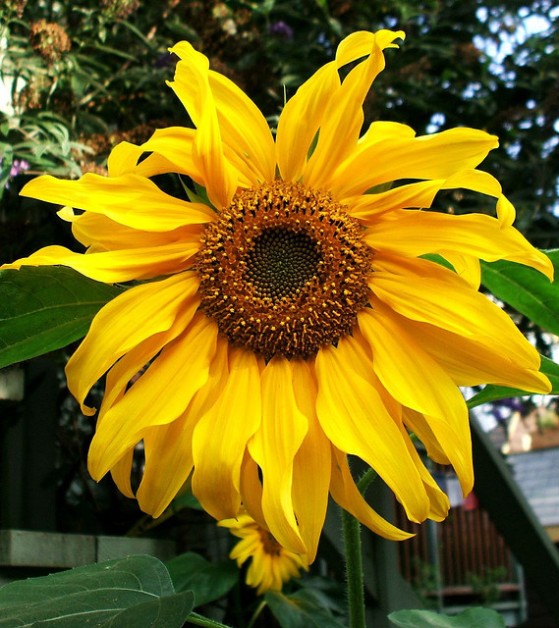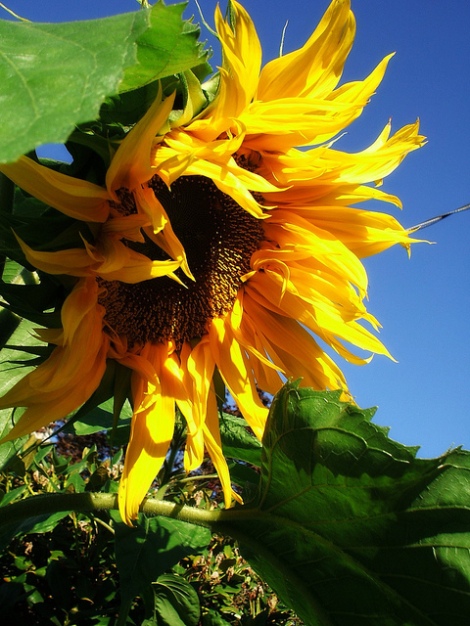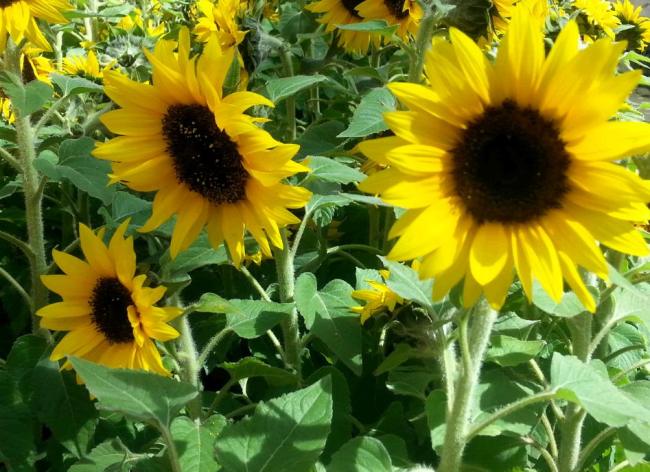Sunflowers make up the genus Helianthus. In Greek, helios means sun and anthos means flower, thus Sunflower. The genus, which contains about 67 species, is thought to be native to the Americas (North, South) originally, and were domesticated around 1000 B.C. Although, Sunflowers are now distributed almost worldwide.
- Kingdom
- Plantae
- Division
- Magnoliophyta
- Class
- Magnoliopsida
- Order
- Asterales
- Family
- Asteraceae
- Genus
- Helianthus
- Species
- annuus
 The large, solitary Sunflower blossom, sometimes as large as a meter in diameter, is composed of yellow ray flowers and a central disk.n The Central disk is composed of either yellow, brown, or purple flowers, depending on the species. The flower is actually a head (formerly composite flower) of numerous flowers crowded together. The outer flowers on the Sunflower are the ray florets and can be yellow, maroon, orange, or other colors. These flowers are sterile. The flowers that fill the circular head inside the ray flowers are called disc florets.
The large, solitary Sunflower blossom, sometimes as large as a meter in diameter, is composed of yellow ray flowers and a central disk.n The Central disk is composed of either yellow, brown, or purple flowers, depending on the species. The flower is actually a head (formerly composite flower) of numerous flowers crowded together. The outer flowers on the Sunflower are the ray florets and can be yellow, maroon, orange, or other colors. These flowers are sterile. The flowers that fill the circular head inside the ray flowers are called disc florets.
Sunflower plants are cultivated in Sunflower farms for their seeds. Refined Sunflower-seed oil is edible, sunflowers have 39 to 49% oil in the seed. Sunflower seed accounts for about 14% of the world production of seed oils (6.9 million metric tons in 1985-86) and about 7% of the oilcake and meal produced from oilseeds. Sunflower oil is generally considered a premium oil because of its light color, high level of unsaturated fatty acids and lack of linolenic acid, bland flavor and high smoke points. Sunflower is the preferred and the most commonly used oil.
Facts About Sunflower
- Sunflower is the national flower of Russia and the state flower of Kansas, USA.
- Sunflower is notable for turning to face the Sun, a behavior known as heliotropism.
- Sunflowers were cultivated by Native Americans well over 1000 years ago.
- Sunflower heads consist of 1,000 to 2,000 individual flowers joined together by a receptacle base. The large petals around the edge of a sunflower head are individual ray flowers which do not develop into seed.
- Sunflower seeds have lots of calcium and 11 other important minerals. They do have 50% fat, but it is mostly polyunsaturated linoleic acid.
- Wild Sunflower is highly branched with small heads and small seeds, in contrast to the single-stem and large seed head of domesticated sunflower. Sunflower perfumes are also popular.
- According to the 1996 Guiness Book of Records, the tallest Sunflower ever grown measured 25 feet 5 and 1/2 inches. According to the 1996 Guiness Book of Records, the smallest sunflower ever grown to maturity measured 2 and 1/5 inches. According to the 1996 Guiness Book of Records, the largest sunflower head measured 32 and 1/4 inches across.
- The Modern Sunflower Kitchens have a large number of sunflower decorated items like sunflower painted crockery, Dinner sets, and living rooms with sunflower wallpaper, S. wallpaper art, S. Wallpaper borders, Sunflower rugs, Sunflower pillows.
- Golden mini Sunflowers herald sunny summer days. The carefree sunflower bouquet sends cheery wishes for all those special occasions – birthday, wedding anniversary, new baby, get well, or to simply say thanks.
Food Uses of Sunflower
 The edible sunflower seeds can be eaten raw, cooked, roasted, or dried and ground for use in bread or cakes, as a snack. The seeds and the roasted seed shells have been used as a coffee substitute. Oil can be extracted and used for cooking and soap making. Yellow dyes have been made from the flowers, and black dyes from the seeds. The residue oil cake has been used as cattle and poultry feed, and high quality silage can be made from the whole plant. The buoyant pith of the stalk has been used in the making of life preservers.
The edible sunflower seeds can be eaten raw, cooked, roasted, or dried and ground for use in bread or cakes, as a snack. The seeds and the roasted seed shells have been used as a coffee substitute. Oil can be extracted and used for cooking and soap making. Yellow dyes have been made from the flowers, and black dyes from the seeds. The residue oil cake has been used as cattle and poultry feed, and high quality silage can be made from the whole plant. The buoyant pith of the stalk has been used in the making of life preservers.
Growing Sunflowers
Sunflowers do best in soil with lots of water holding capacity, drainage and fertilzer. Sunflower roots grow deep and spread a lot, so they can stand a dryspell every now and then. You should not over water a sunflower 20 days before and 20 days after flowering. This might deform the flower heads. If you really want your sunflower to do well, do soil tests. Too high nitrogen is not good, and make sure you have potassium and phosphorus in the soil.
- Start by planting seeds in damp soil 1-2″ deep.
- Seeds should be space 12 inches apart in rows that are 2 to 2 1/2 feet apart.
- If you want your sunflower to have a large head, space further apart and scatter them around the garden.
- They usually start to appear within a two week time frame.
- They should be completely grown in 80-90 days.
Sunflower Plant Care
- Weed control should usually be done by hand-weeding or with the use of herbicides to avoid damging shallow roots.
- Fertilization should be based on the results of a soil test. In the absence of a soil test, apply a complete fertilizer such as 8-8-8 or 10-10-10 at the rate of 1 to 2 pounds per 100 square feet of bed area just before new shoots emerge in the early spring.
- Avoid touching any emerging leaves with fertilizer to avoid leaf damage.
- Many newly planted perennials will not bloom the first year. A few, such as peonies, may take several years to bloom heavily.
- Many perennials should be staked to prevent them from bending or falling over during wind and rain. When staking is done correctly, the plants grow to cover the stakes.
- Remove old flowers to encourage rebloom on perennials. Many perennials should be cut back to ground level after blooming is finished to encourage new leaf growth from the base.
- Remove dead foliage and stems in the fall, and mulch to protect crowns and roots from alternating mild and freezing weather.
- Most perennials eventually become overcrowded and require division. Many perennials are also easily propagated in this way. Other methods of propagating perennials include stem cuttings, root cuttings and seed.















![20170123050651-f09370cbed.[gif-2-mp4.com] 20170123050651-f09370cbed.[gif-2-mp4.com]](https://live.staticflickr.com/428/32472212275_9af8805d25_m.jpg)


